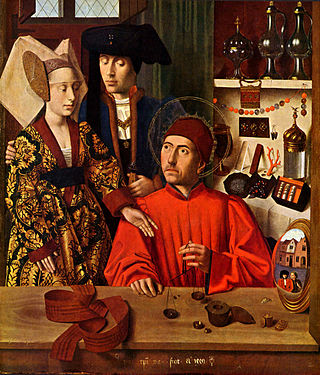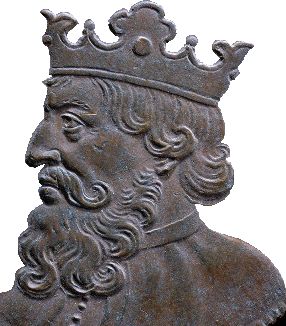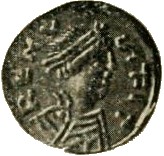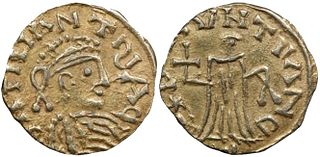Related Research Articles

Year 660 (DCLX) was a leap year starting on Wednesday of the Julian calendar. The denomination 660 for this year has been used since the early medieval period, when the Anno Domini calendar era became the prevalent method in Europe for naming years.

Gregory of Tours was a Gallo-Roman historian and Bishop of Tours during the Merovingian period and is known as the "father of French history". He was a prelate in the Merovingian kingdom, encompassing Gaul's historic region.

Austrasia was the northeastern kingdom within the core of the Frankish Empire during the Early Middle Ages, centring on the Meuse, Middle Rhine and the Moselle rivers. It included the original Frankish-ruled territories within what had been the northernmost part of Roman Gaul, and cities such as Cologne, Trier and Metz. It also stretched beyond the old Roman borders on the Rhine into Frankish areas which had never been formally under Roman rule. It came into being as a part of the Frankish Empire founded by Clovis I (481–511). At the same time, the initial powerbase of Clovis himself was the more Romanized part of northern Gaul, lying southwest of Austrasia, which came to be known as Neustria.

Chlothar II, sometimes called "the Young", was king of the Franks, ruling Neustria (584–629), Burgundy (613–629) and Austrasia (613–623).

Chilperic I was the king of Neustria from 561 to his death. He was one of the sons of the Frankish king Clotaire I and Queen Aregund.

The Kingdom of the Franks, also known as the Frankish Kingdom, the Frankish Empire or Francia, was the largest post-Roman barbarian kingdom in Western Europe. It was ruled by the Frankish Merovingian and Carolingian dynasties during the Early Middle Ages. Francia was among the last surviving Germanic kingdoms from the Migration Period era.

Sigebert I was a Frankish king of Austrasia from the death of his father in 561 to his own death. He was the third surviving son out of four of Clotaire I and Ingund. His reign found him mostly occupied with a successful civil war against his half-brother, Chilperic.
Fredegund or Fredegunda was the queen consort of Chilperic I, the Merovingian Frankish king of Soissons. Fredegund served as regent during the minority of her son Chlothar II from 584 until 597.

Saint Gontrand, also called Gontran, Gontram, Guntram, Gunthram, Gunthchramn, and Guntramnus, was the king of the Kingdom of Orléans from AD 561 to AD 592. He was the third-eldest and second-eldest-surviving son of Chlothar I and Ingunda. On his father's death in 561, he became king of a fourth of the Kingdom of the Franks, and made his capital at Orléans. The name "Gontrand" denotes "War Raven".

Germain was the bishop of Paris and is venerated as a saint in both the Catholic Church and the Eastern Orthodox Church. According to an early biography, he was known as Germain d'Autun, rendered in modern times as the "Father of the Poor".
Brunhilda was queen consort of Austrasia, part of Francia, by marriage to the Merovingian king Sigebert I of Austrasia, and regent for her son, grandson and great-grandson.
Odo the Great, was the Duke of Aquitaine by 700. His territory included Vasconia in the south-west of Gaul and the Duchy of Aquitaine, a realm extending from the Loire to the Pyrenees, with the capital in Toulouse. He fought the Carolingian Franks and made alliances with the Moors to combat them. He retained this domain until 735. He is remembered for defeating the Umayyads in 721 in the Battle of Toulouse. He was the first to defeat them decisively in Western Europe. The feat earned him the epithet "the Great". He also played a crucial role in the Battle of Tours, working closely with Charles Martel, whose alliance he sought after the Umayyad invasion of what is now southern France in 732.
The title Duke(and Prince)of the Franks (Latin: dux(et princeps)Francorum) has been used for three different offices, always with "duke" implying military command and "prince" implying something approaching sovereign or regalian rights. The term "Franks" may refer to an ethnic group or to the inhabitants of a territory called Francia.
Hugobert was a seneschal and a count of the palace at the Merovingian court during the reigns of Theuderic III and Childebert III. He was a grandson of the dux Theotar, and it is assumed, but not proven, that his father was Chugus, who in 617 became mayor of the palace of Austrasia. The juxtaposition of names in the Vita Landiberto episcopi Traiectensis may imply a relationship between him and the family of Saint Lambert.
Austrovald, Astrobald, and Austrevald was the Duke of Aquitaine from 587.
Bladast or Bladastes was a Frankish dux during the reigns of Chilperic I and Chlothar II.
Desiderius was a Gallo-Roman dux in the Kingdom of the Franks during the reigns of Chilperic I and Guntram. He served Chilperic as Duke of Aquitaine and was his greatest general.
Mummolus, was a Gallo-Roman patrician and prefect who served Guntram, King of Burgundy, as a general in the 6th century.
Chlodosinda was a Frankish princess, the daughter of King Sigebert I and Queen Brunhilda.

Gontran Boson, also known as Gontran The Cunning, was a Frankish duke in the service of the Merovingian kings Sigebert I and Childebert II. He was born around 545 and died in 587.
References
- Lewis, A. R. (1976). "The Dukes in the Regnum Francorum, A.D. 550–751". Speculum . 51 (3): 381–410. doi:10.2307/2851704. JSTOR 2851704. S2CID 162248053.
- Reimitz, Helmut (2015). History, Frankish Identity and the Framing of Western Ethnicity, 550–850. Cambridge University Press.
- Stiennon, Jacques (1979). "Le sarcopharge de Sancta Chrodoara à Saint-Georges d'Amay: Essai d'interprétation d'une découverte exceptionnelle". Comptes rendus des séances de l'Académie des Inscriptions et Belles-Lettres. 123 (1): 10–31.
- Wickham, Chris (2005). Framing the Early Middle Ages: Europe and the Mediterranean, 400–800. Oxford University Press.